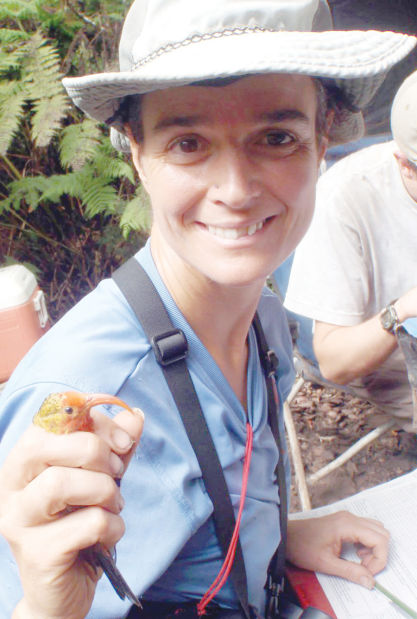HANAPEPE — The Anianiau is one of six Kauai forest birds found nowhere else on Earth, restricted to the high elevations of Kokee and the Alakai Swamp. Editor’s note: This is an ongoing weekly feature in The Garden Island. It
HANAPEPE — The Anianiau is one of six Kauai forest birds found nowhere else on Earth, restricted to the high elevations of Kokee and the Alakai Swamp.
Editor’s note: This is an ongoing weekly feature in The Garden Island. It focuses on everyday people who reflect the spirit that makes Kauai the place it is today.
HANAPEPE — The Anianiau is one of six Kauai forest birds found nowhere else on Earth, restricted to the high elevations of Kokee and the Alakai Swamp.
Weighing in at less than four pennies, it is one of Hawaii’s smallest native birds, characterized by its bright greenish-gold feathers and pinkish bill.
Of all Kauai’s songbirds, the Anianiau is Dr. Lisa “Cali” Crampton’s favorite.
“I like this guy,” she said, pointing to a picture. “It’s just like a lemondrop hanging in the tree. It’s just so cute, so small, so sweet.”
Since 2010, Crampton has worked as coordinator of the Kauai Forest Bird Recovery Project, which primarily focuses on research and recovery of three federally endangered species — Puaiohi, Akikiki and Akekee — as well as Kauai’s other native songbirds, including the Anianiau.
“When people see how beautiful these birds are and learn how few there are left, they’re going to want to do something,” said Crampton.
Take KFBRP’s three target species for example. Today, there are less than 1,000 of each, found only in a 25-square-kilometer area of the Alakai, according to Crampton.
“We’re talking about the last few birds,” she said.
The Puaiohi, or Small Kauai Thrush, are among the most secretive, nesting on steep cliffs along streams in the Alakai. Its population is thought to be as low as 500.
Long ago, songbirds somehow managed to make it to Hawaii. Over time, they evolved into dozens of unique species perfectly adapted to the isolated tropical islands they call home.
With human colonization, however, came the destruction of their native forest habitat and the introduction of alien species, including malaria-carrying mosquitos and predators like rats and feral cats.
Since then, seven of Kauai’s original 13 forest birds have gone extinct, including five since the 1960s. Of the eight that remain, six are found only on Kauai, according the KFBRP.
“We’re trying to bridge this disconnect between these birds that have now been so impacted by human mediated activities that they’ve been forced far up into the Alakai, so they’re sort of out of sight, out of mind,” Crampton said. “Yet, they’re an important part of Hawaiian culture and our island ecosystem.”
It’s all about promoting knowledge and conservation, with an ultimate goal of recovering the species to healthy populations.
Crampton and her small team of bird enthusiasts aren’t afraid to get dirty. Sometimes they camp out deep in the muddy Alakai, spending their days monitoring, tagging and conducting transect surveys.
Surveying is a job that requires a keen sense of hearing.
Each bird has its own unique song. And just by listening, Crampton said you can get not only an idea of what kinds of birds are in an area, but how many.
“I’m not particularly good at it,” she admitted, adding that KFBRP Field Crew Leader Barbara Heindl is much better. “The more you do it, the better.”
For the secretive Puaiohi, however, Crampton said the project had to develop its own special survey method that uses social attraction.
“Instead of just standing and listening, we stand and listen and then after a few minutes we play some of their songs and see if they come in closer and start vocalizing,” she said.
Of all the songs, the Anianiau’s is the sweetest. A sort of “here I am” type of call, Crampton said.
Today, KFBRP is trying to figure out what is forcing the birds to higher elevations. And the answer for one bird may be different from another.
In addition to their surprisingly low populations, Crampton said most people are unaware of the connections between climate change and disease when it comes to these birds.
While she has always admired birds, Crampton, who has a Ph.D in Ecology, Evolution and Conservation Biology from the University of Nevada at Reno, was never a fanatic.
“I have not only studied birds — I studied snakes. I studied bats. I studied chipmunks,” she said. “I think birds are super cool. There’s, I mean, flight to begin with. And feathers. But I think what I like about birds is all the mutualisms they’ve developed. And when you have them in the hand they’re spectacular. Their feathers are so glossy and shiny and soft. And they are so strong, even for being so small.”
With a limited staff, KFBRP is always looking for folks to help out, whether it’s monitoring rat traps as part of its predator control efforts, catching and tagging birds, or working in the Hanapepe office.
Crampton says part of the barrier in getting people to care about and support conservation measures for these birds is that many people don’t really know that they’re there, or how much trouble they are in.
“Everyone gets these messages all the time — turn off your lights, recycle, whatever,” Crampton said. “But if they can maybe connect them closer to home and understand that it’s impacting the birds on the island they live on, it’s not something across the ocean, maybe it will ring a little truer with them.”
“People’s everyday actions make a big difference to conservation on our island,” she added.
• Chris D’Angelo, environmental reporter, can be reached at 245-0441 or cdangelo@thegardenisland.com.
If you know a person you would like to see featured in The Garden Island, who is lokomaikai, email Lisa Ann Capozzi at lcapozzi@thegardenisland.com



